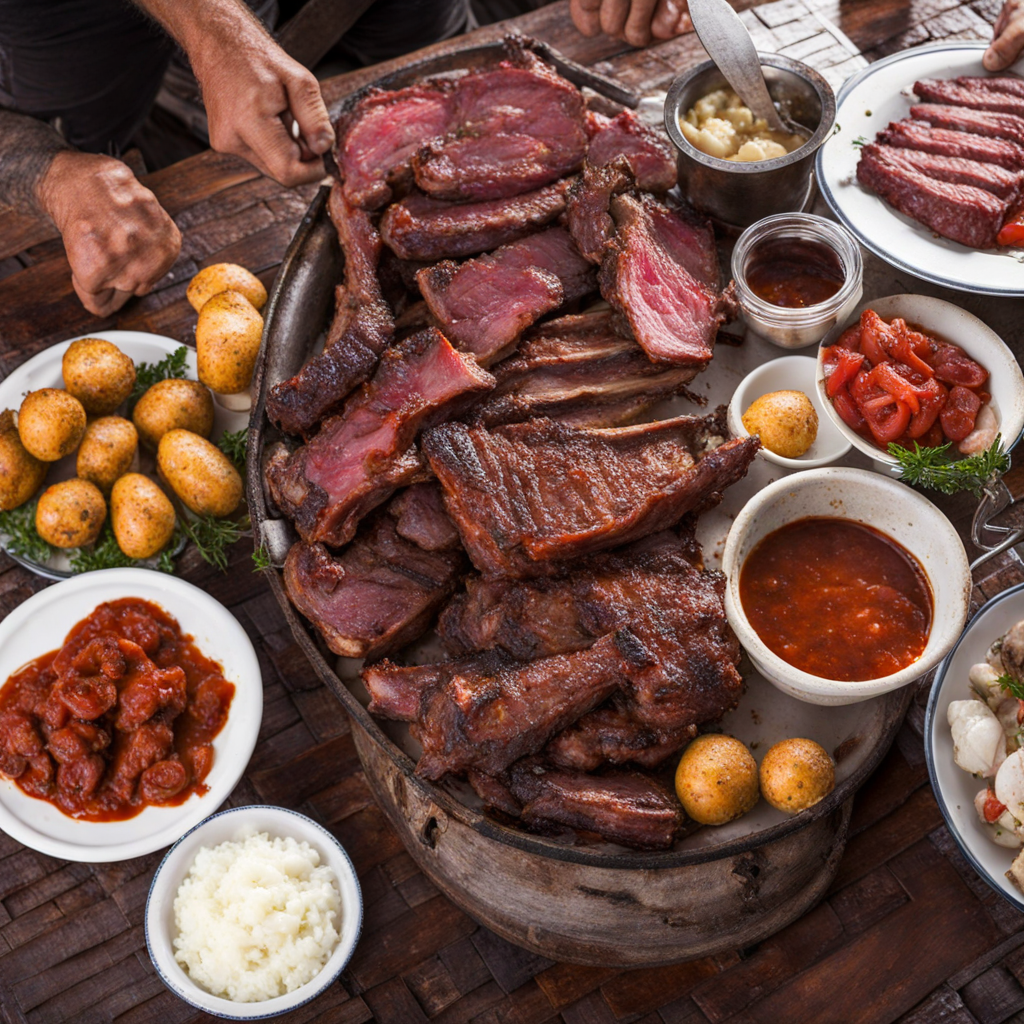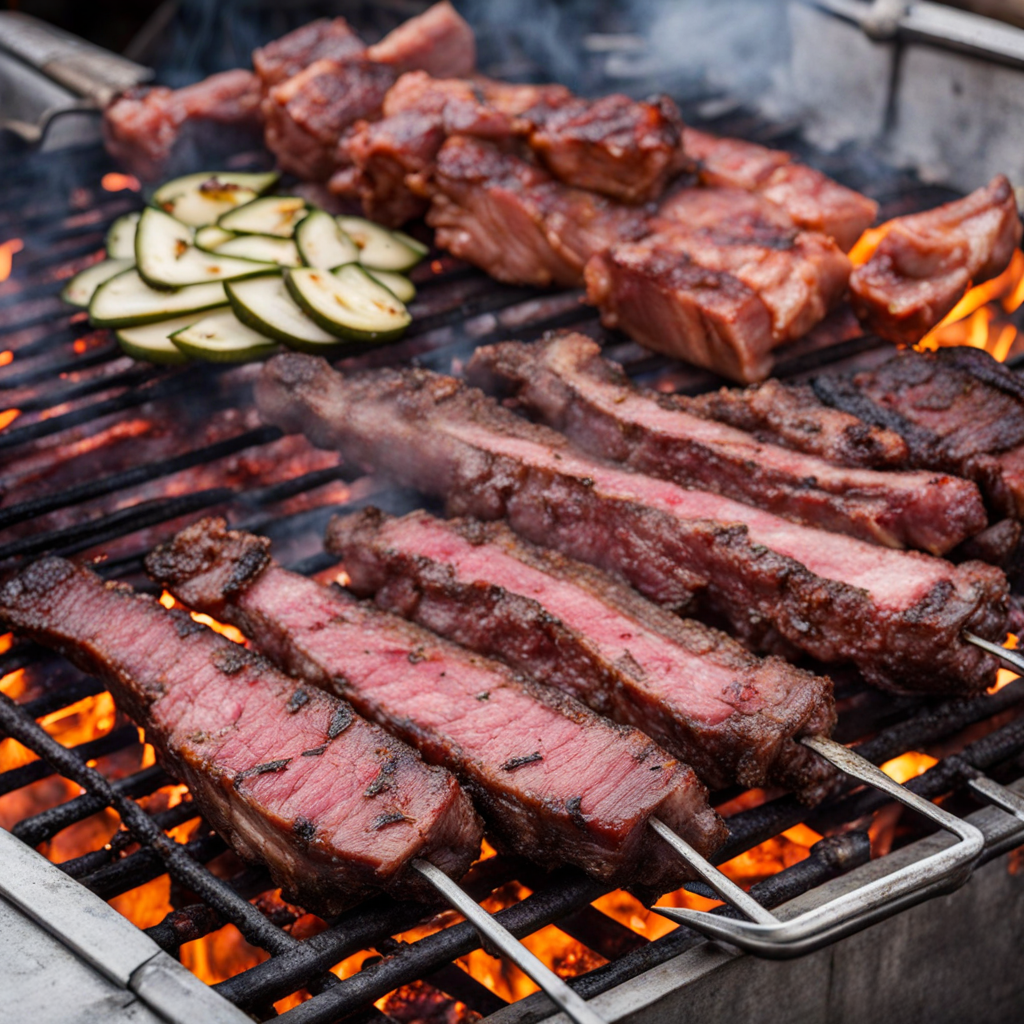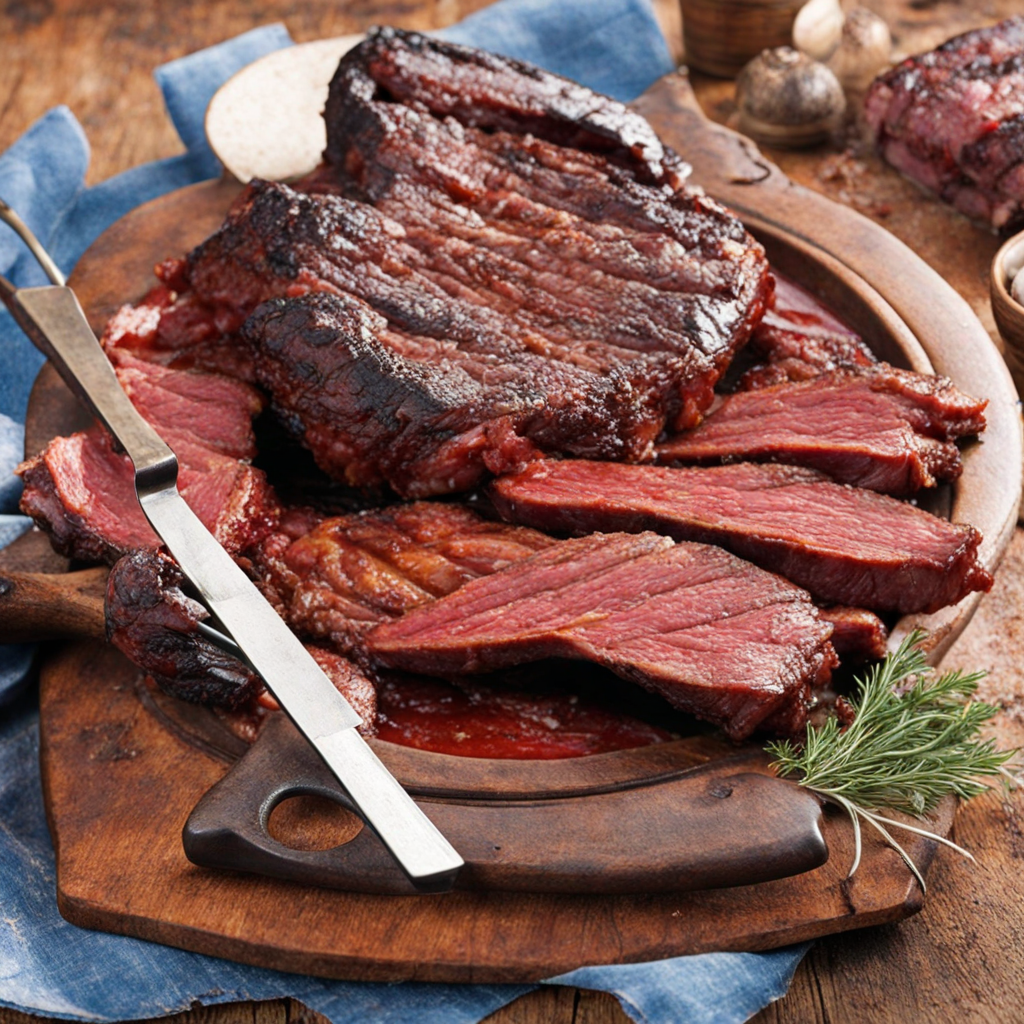Asado
Asado is a traditional Uruguayan barbecue that embodies the essence of the country's culinary culture. It is not just a method of cooking; it is a social event that brings friends and family together around a fire. The centerpiece of any asado is the meat, which is typically a selection of beef cuts such as ribs, flank steak, and short ribs, often seasoned simply with salt to enhance the natural flavors. As the meat grills over an open flame or charcoal, it develops a smoky aroma and a beautifully charred crust, while the inside remains juicy and tender, creating a delightful contrast in textures. Accompanying the meat are classic sides that elevate the experience, such as chimichurri sauce, a vibrant, herbaceous blend of parsley, garlic, vinegar, and oil that adds a zesty kick to the rich flavors of the beef. Additionally, traditional accompaniments like grilled vegetables, potatoes, and the popular Uruguayan bread called "pan" provide a hearty balance to the meal. The ritual of preparing and sharing asado often involves communal cooking, where the host takes on the role of the "asador" (grill master) and everyone gathers around to enjoy the warm atmosphere, delicious aromas, and the sound of sizzling meat. The experience of tasting asado goes beyond just the food; it is steeped in history and reflects the pride of Uruguayan identity. Each bite carries with it a sense of tradition and connection to the land, as Uruguay is known for its high-quality beef raised on sprawling pastures. Enjoying asado is an invitation to indulge in the flavors of Uruguay while appreciating the communal aspect that makes it a cherished culinary experience. Whether enjoyed during a festive gathering or a cozy family dinner, asado offers a unique taste that invites anyone to explore the rich and hearty flavors of Uruguayan cuisine.
How It Became This Dish
The History of Asado in Uruguay: A Culinary Tradition Origins of Asado Asado, a term that translates to “roast” in Spanish, refers to a traditional method of cooking meat, predominantly beef, over an open flame or grill, and is deeply embedded in the cultural and culinary fabric of Uruguay. Its roots can be traced back to the gauchos, the iconic cowherds of the South American pampas, who became synonymous with a lifestyle centered around cattle ranching and outdoor cooking. The gaucho culture emerged in the 18th century when Spanish settlers introduced cattle to the region, and these hardy individuals adapted to the vast, grassy plains of Uruguay and Argentina. The cooking style of asado is believed to have developed organically from the necessity of preparing food in the open air, utilizing the resources available in the environment. Gauchos would often gather around a fire to cook large cuts of meat, which were seasoned simply with salt, allowing the natural flavors to shine through. Over time, this practice evolved into a communal event, fostering social bonds and a sense of community among those who participated. The simplicity and communal nature of asado became a hallmark of Uruguayan and Argentine culture. Cultural Significance Asado is not merely a cooking technique; it is a significant cultural event that encapsulates the spirit of Uruguay. It represents a way of life that emphasizes family, friendship, and togetherness. In Uruguayan society, asado is often the centerpiece of social gatherings, celebrations, and holidays. It is common for families and friends to come together around the grill (parrilla) on weekends, holidays, and special occasions, making it a cherished ritual that strengthens social bonds. The preparation of asado is a communal affair, often involving several participants in the cooking process. The selection of the meat, the seasoning, and the timing all become part of the shared experience. Traditional cuts include short ribs (asado de tira), flank steaks (vacío), and sausages (chorizo), among others. The meat is typically seasoned with coarse salt, and the grilling is done slowly over wood or charcoal, allowing the flavors to develop fully. The act of grilling itself becomes a social performance, with the “asador” (the person in charge of the grill) taking on a revered role, often celebrated for their skill and expertise. Asado is also interconnected with the concept of hospitality in Uruguayan culture. Inviting someone to share an asado is a gesture of friendship and warmth, and it is common for guests to contribute by bringing drinks, sides, or desserts. The tradition of sharing food fosters a sense of community and belonging, as people gather around the fire to enjoy not just the meal but each other's company. Development Over Time The practice of asado has evolved significantly since its inception. In the 19th century, as Uruguay gained independence and established its national identity, asado began to take on a more formalized role in society. The growth of cities and urbanization brought changes to how asado was conducted. While traditional rural methods persisted, the urban landscape saw the rise of specialized parrillas, or steakhouses, which catered to the growing population. These establishments became popular dining spots, showcasing the flavors and techniques of asado to a broader audience. The 20th century introduced new dimensions to asado, particularly with the influence of Italian and Spanish immigrants. They brought with them culinary traditions that integrated seamlessly with the existing asado culture, leading to the incorporation of new ingredients, cooking methods, and flavors. For instance, the use of chimichurri, a vibrant sauce made from parsley, garlic, vinegar, and olive oil, became a staple accompaniment to asado, enhancing the flavors of the grilled meats. In the late 20th and early 21st centuries, asado became a symbol of national pride in Uruguay. The popularity of beef from the region, renowned for its quality and flavor, further solidified asado’s status as a cultural icon. The Uruguayan government has even recognized asado as an essential part of the nation’s gastronomic heritage, contributing to its promotion as a cultural treasure. In 2016, Uruguay’s asado was included in the list of intangible cultural heritage by UNESCO, acknowledging its significance in fostering social cohesion and cultural identity. Global Influence and Modern Adaptations In recent decades, asado has transcended its local roots and gained international recognition. The global rise of Latin American cuisine has showcased asado at culinary festivals, food fairs, and restaurants around the world. Chefs have embraced the traditional cooking methods while experimenting with flavors and presentations, allowing asado to evolve in new directions. The popularity of barbecue culture in other parts of the world has led to a fusion of styles that incorporates asado techniques, reflecting the adaptability and universality of this cooking method. Modern asado gatherings often incorporate a variety of dishes beyond the traditional cuts of meat. Sides such as grilled vegetables, salads, and artisanal bread have become common accompaniments, reflecting contemporary culinary trends. The use of different marinades, spices, and techniques, such as smoking or indirect grilling, has also introduced creative interpretations of asado, appealing to a broader audience. Moreover, the rise of social media has allowed the asado culture to flourish in new ways. Enthusiasts share their experiences, recipes, and cooking techniques online, creating a vibrant community dedicated to celebrating this beloved tradition. Asado contests and festivals are now organized, showcasing the skills of both amateur and professional asadores, further solidifying its place within culinary culture. Conclusion Asado is more than a method of cooking; it is an integral part of Uruguayan identity, reflecting the nation’s history, culture, and social values. From its gaucho origins to its contemporary adaptations, asado has evolved while remaining deeply rooted in tradition. It embodies the spirit of community, hospitality, and celebration, making it a cherished culinary ritual that continues to thrive in Uruguay and beyond. Asado is a testament to the power of food to bring people together, fostering connections that transcend generations and borders.
You may like
Discover local flavors from Uruguay







